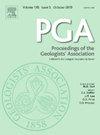阿尔及利亚阿普提亚(白垩纪)首次记录蛇形聚集体和可能的蛇形礁
IF 1.3
4区 地球科学
Q2 Earth and Planetary Sciences
引用次数: 0
摘要
最早的蛇形聚集体是在非洲白垩纪描述的。蛇形种Parsimonia cf. antiquata形成扇形小聚集体,直径可达25 cm。蛇形体并没有保存在原位,大部分材料可能来自附近较大的蛇形礁。蛇形礁可能出现在泻湖或边缘海洋环境中。阿尔及利亚的蛇形聚集体在动物群多样性方面比现代的蛇形礁更像蛇形石灰岩。泻湖通常有泥泞或沙质的底部,那里的蛇形聚集体可能是幼虫栖息的唯一大型硬基质。合适底物的有限数量可能支持了聚集物的生长。阿尔及利亚阿普提安丰富的悬浮食物资源也可能促进了蛇形珊瑚礁的生长。本文章由计算机程序翻译,如有差异,请以英文原文为准。
First record of serpulid aggregations and possible serpulid reefs from the Aptian (Cretaceous) of Algeria
First serpulid aggregations have been described from the Cretaceous of Africa. The serpulid species Parsimonia cf. antiquata formed fan-shaped small aggregations up to 25 cm in diameter. The serpulids are not preserved in situ, and most of the material may have been derived from nearby larger serpulid reefs. The serpulid reefs presumably occurred in a lagoon or marginal marine environment. The Algerian serpulid accumulations resemble more serpulid limestones in their low faunal diversity than modern serpulid reefs with diverse associating fauna. The lagoons often have muddy or sandy bottoms where the serpulid aggregations could have been the only large hard substrates for larvae to settle. The restricted number of suitable substrates may have supported the growth of aggregations. Rich suspended food resources also likely enhanced the growth of serpulid reefs in the Aptian of Algeria.
求助全文
通过发布文献求助,成功后即可免费获取论文全文。
去求助
来源期刊
CiteScore
2.70
自引率
8.30%
发文量
54
审稿时长
6-12 weeks
期刊介绍:
The Proceedings of the Geologists'' Association is an international geoscience journal that was founded in 1859 and publishes research and review papers on all aspects of Earth Science. In particular, papers will focus on the geology of northwestern Europe and the Mediterranean, including both the onshore and offshore record. Following a long tradition, the PGA will focus on: i) a range of article types (see below) on topics of wide relevance to Earth Sciences ii) papers on aspects of Earth Science that have societal relevance including geoconservation and Earth management, iii) papers on palaeoenvironments and palaeontology of the Mesozoic and Cenozoic, iv) papers on aspects of Quaternary geology and climate change, and v) papers on the history of geology with particular reference to individuals that have shaped the subject. These topics will also steer the content of the themes of the Special Issues that are published in the PGA.

 求助内容:
求助内容: 应助结果提醒方式:
应助结果提醒方式:


